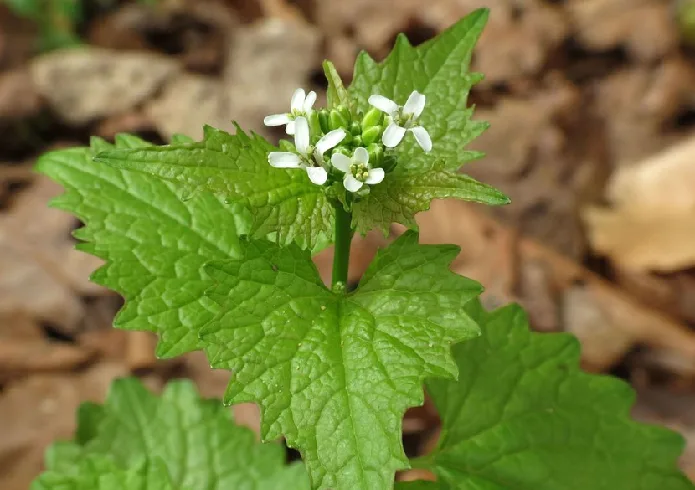
See the invasive plant that's almost impossible get rid of
Garlic mustard is an invasive plant brought to North America from Europe. Its aggressive growth in natural woodland areas, agricultural fields, and home gardens negatively impacts landowners and Ontario wildlife by forming dense stands that crowd out other plant species. It’s not impossible to get rid of, but you need to approach the job properly, or you’ll just help it spread even more.

Garlic mustard is a biennial plant: it requires two years to complete its life cycle. During its first year, the plant sprouts as a low-growing, circular arrangement of kidney-shaped leaves with scalloped edges. These leaves stay green over the winter beneath snow, which gives the plant a head-start in claiming growing space and sunlight over native plants in the spring. In its second year, garlic mustard shoots up to a metre in height and produces tiny, white, flowers with four petals. These flowers yield seed pods with hundreds of black seeds, allowing garlic mustard stands to rapidly expand.
Summer revealed! Visit our Complete Guide to Summer 2019 for an in depth look at the Summer Forecast, tips to plan for it and much more
Garlic mustard’s growth in Ontario’s forests threatens the West Virginia White butterfly, a species of Special Concern in Ontario. These butterflies lay their eggs on a native Ontario plant, two-leaved toothwort. Kate Powell, Terrestrial Specialist with Ontario’s Invading Species Awareness Program, says, “Not only does garlic mustard out-compete two-leaved toothwort in terms of habitat, but it is also toxic to the developing larvae which are accidentally deposited on the invasive plant, as adult butterflies cannot differentiate between the two species.”
FEATURED VIDEO: CHECK OUT THIS AMAZING BUBBLE PLANT
It’s not just butterflies that get confused by garlic mustard. People can easily mistake it for other native Ontario species such as violets and wild ginger. A simple test can verify if a plant is invasive garlic mustard: crushing the plant’s leaves will produce a pungent garlic aroma.
For cottagers looking to remove garlic mustard from their property, Powell says, “Garlic mustard is relatively easy to manage because all you need is a little elbow grease and persistence.” She recommends targeting the plant in the spring of its second year of growth, before the plant produces its long seedpods. ”It’s very easy to pull out but if you target it after a rainfall the soil will be much more manageable.”
Garlic mustard must be disposed of responsibly, to ensure seeds don’t accidentally spread into new areas. Tightly secure pulled plants in black garbage bags and leave the bags in sunlight to “cook” the plants and kill off any remaining seeds. After a couple of weeks, the garbage bags can be sent to landfill. Powell advises against composting garlic mustard; compost facilities may not adequately destroy the plant material.
Tackling garlic mustard does require property owners to play a long game and devote time annually to removing patches. “You’ll need to revisit the site every spring for quite some time because the seeds can remain viable in the soil for up to 10 years,” says Powell. For advice throughout the removal process, Ontario’s Invading Species Awareness Program has a toll-free Invading Species Hotline, 1-800-563-7711.
This article was written for Cottage Life by Grace Hunter.





